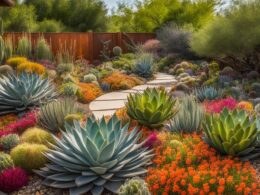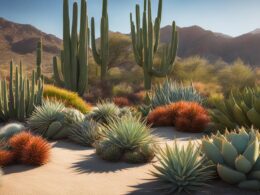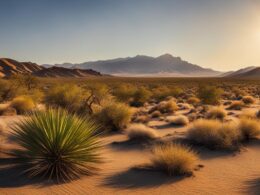Gardening with native plants can be incredibly rewarding. Native wildflowers, ferns, grasses, shrubs, and trees are beautiful, versatile, and easy to grow. Many native plants are drought-tolerant, meaning they can thrive in dry conditions without requiring regular irrigation. Choosing drought-resistant native plants for your garden can help you save water and create a verdant oasis that withstands prolonged or occasional droughts. In this guide, we will explore 37 fantastic native plants that are ideal for your garden.
Key Takeaways:
- Native plants are beautiful, versatile, and easy to grow in your garden.
- Drought-tolerant native plants can thrive in dry conditions without regular irrigation.
- Choosing drought-resistant native plants helps save water and withstand droughts.
- This guide will explore 37 fantastic native plants for your garden.
- By growing drought-resistant native plants, you can create a verdant oasis that requires minimal watering.
Tips for Selecting Drought-Tolerant Plants
When it comes to selecting drought-tolerant plants for your garden, there are a few tips to keep in mind. By considering these factors, you can ensure that the plants you choose will thrive in your specific conditions and help conserve water.
- Know Your USDA Plant Hardiness Zone: Before selecting plants, determine your hardiness zone. This will help you identify which plants are best suited for your local climate and growing conditions. You can easily find this information online or by consulting with your local extension office.
- Choose Plants Recommended for Your Hardiness Zone: Once you know your hardiness zone, look for plants that are recommended for that specific zone. These plants are more likely to be well-adapted to your area and have a better chance of surviving and thriving in your garden.
- Observe Native Plants in the Wild: Take note of the native plants you see growing in the wild near your location. These plants are already adapted to the local climate and soil conditions, making them excellent choices for your garden. Pay attention to their water requirements and consider incorporating similar species into your landscape.
“By choosing drought-tolerant plants that are well-suited for your specific conditions, you can reduce water usage in your garden while still enjoying a beautiful and vibrant landscape.”
Prepare your planting area by amending the soil and matching it to the preferred soil type of the plants you choose. Consider the sun requirements and watering needs of each plant to ensure they will thrive in your garden. It is also important to transplant most plants in early spring or fall, keep the garden free of weeds, and choose plants that fit the available space in your garden.
Table: Recommended Drought-Tolerant Plants for Different Hardiness Zones
| Hardiness Zone | Recommended Plants |
|---|---|
| Zone 5 | Liatris, Sedum, Yarrow |
| Zone 8 | Agave, Coreopsis, Lavender |
| Zone 9 | Agapanthus, Grevillea, Salvia |
These are just a few examples of recommended plants for specific hardiness zones. Research and consult with local nurseries or gardening experts to find more options that are suitable for your area.
By following these tips and selecting drought-tolerant plants that are well-suited for your specific conditions, you can reduce water usage in your garden while still enjoying a beautiful and vibrant landscape.
Designing a Thriving Oasis of Native Plants
Now that you have chosen your drought-resistant native plants and prepared your garden site, it’s time to design a thriving oasis of native plants. By strategically arranging your plants and considering their growth habits and needs, you can create a visually appealing and sustainable landscape.
Creating Visual Interest
When designing your native plant oasis, think about the overall visual impact you want to achieve. Consider placing taller plants and shrubs towards the back of the garden to create depth and provide a backdrop for smaller plants. This layering technique will add visual interest and make your garden look more lush and vibrant.
You can also create focal points by grouping clusters of flowering plants together. This not only adds pops of color to your landscape but also attracts pollinators like bees, butterflies, and birds. By choosing a variety of plants that flower at different times, you can ensure that your garden remains colorful and vibrant throughout the season.
Maximizing Space and Growth
When planting your native plants, give each new plant plenty of space to grow. This allows their root systems to develop fully and prevents overcrowding, which could lead to competition for resources. Additionally, consider planting lower-growing ground covers in the front of your display to create a seamless transition from the ground to taller plants in the background.
If you have limited space in your garden, don’t be afraid to get creative. Many native plants can be grown in containers, hanging baskets, or vertical gardens, allowing you to maximize your available space while still enjoying the beauty of native plants.
Sharing and Expanding Your Native Plant Collection
“In nature, nothing exists alone.” – Rachel Carson
Building a thriving oasis of native plants is not only about the plants themselves but also about the sense of community and connection that comes with it. Don’t hesitate to reach out to fellow gardening enthusiasts and see if they have any native plants they are willing to share. Many native plants can be started from seeds or divided from existing clusters, making it easy to expand your collection and share the beauty of native plants with others.
As you continue to nurture your native plant oasis, remember to observe and appreciate the intricate relationships between plants, insects, birds, and other creatures that are part of your ecosystem. By designing a thriving oasis of native plants, you are not only creating a beautiful landscape but also contributing to the conservation and preservation of your local environment.
| Native Plant | Scientific Name | Bloom Time | Height | Preferred Soil |
|---|---|---|---|---|
| Black-eyed Susan | Rudbeckia hirta | Mid-summer to early fall | 2-3 feet | Well-drained |
| Butterfly Milkweed | Asclepias tuberosa | Summer | 2-3 feet | Dry to medium |
| Climbing Aster | Aster carolinianus | Summer to fall | 3-6 feet | Well-drained |
| Purple Coneflower | Echinacea purpurea | Summer to fall | 2-5 feet | Well-drained |
| Eastern Prickly-pear | Opuntia humifusa | Spring | 1-2 feet | Dry to medium |
Drought-Tolerant Native Plants for Your Garden
As you strive to create a beautiful and sustainable garden, incorporating drought-tolerant native plants is a smart choice. These plants are adapted to thrive in your local climate and require minimal watering once established, making them ideal for conserving water and maintaining a vibrant garden even during dry spells. Here are some stunning drought-tolerant native plants that you can consider for your garden:
| Plant | Description | Watering Needs |
|---|---|---|
| Adam’s Needle | A succulent plant with large, stiff leaves | Low water requirements |
| Anise-scented Goldenrod | A self-seeding perennial with fragrant leaves and bright yellow flowers | Drought-tolerant once established |
| Beebalm | A fragrant member of the mint family that thrives in open grasslands | Moderate water needs |
| Big Bluestem | A tall and ornamental native grass that is beneficial for erosion control | Adapts well to dry conditions |
| Black-eyed Susan | A beautiful plant that blooms from mid-summer to early fall | Requires little water once established |
These are just a few examples of the many drought-tolerant native plants available for your garden. By selecting plants that are well-suited to your local climate and soil conditions, you can create a stunning and sustainable oasis that conserves water and attracts pollinators. Remember to provide proper spacing between plants to allow for their growth, and consider grouping them strategically to enhance visual appeal.
When establishing your drought-tolerant native plant garden, it’s important to note that these plants may require regular watering during their initial growth phase. However, once they have taken root and become established, they will require minimal intervention. This not only saves water but also reduces the maintenance required to keep your garden thriving and beautiful.
So, embrace the beauty and resilience of drought-tolerant native plants in your garden. Not only will you create a visually stunning landscape, but you will also contribute to water conservation efforts and support the natural ecosystem.
Native Plants for Water Conservation
Conserving water during a drought is crucial, and one effective way to do so is by incorporating native plants into your garden. Native plants are naturally more drought-tolerant as they are adapted to the local climate and soil conditions. By choosing native plants, you not only reduce the demand for water but also create a more sustainable and environmentally friendly landscape.
When you plant native species in your garden, they require less watering compared to non-native plants. Native plants have deep root systems that can access water sources deep within the soil, making them well-suited to withstand dry conditions. Additionally, native plants have evolved to thrive in the specific climate of your region, so they are more likely to survive and flourish even during periods of drought.
The North Carolina Botanical Garden has compiled a list of recommended drought-tolerant native plants that are ideal for the Piedmont region. Some of these native plants include Climbing Aster, Butterfly Milkweed, Purple Coneflower, Eastern Prickly-pear, and more. By choosing these plants, you can create a beautiful and water-conserving garden that supports the local ecosystem.
To further minimize water usage, consider utilizing alternative water sources for irrigation. Rainwater collected in rain barrels, air conditioner condensation, or other sources can be used to water your native plants. This reduces your reliance on municipal water supplies and promotes a more sustainable approach to gardening.
| Native Plant | Description | Best Growing Conditions |
|---|---|---|
| Climbing Aster | A vine-like plant with purple flowers that attracts pollinators. | Full sun, well-drained soil. |
| Butterfly Milkweed | A vibrant orange flowering plant that is a host for monarch butterflies. | Full sun, dry to medium soil. |
| Purple Coneflower | A cone-shaped flower with purple petals that attracts butterflies and bees. | Full sun to light shade, well-drained soil. |
| Eastern Prickly-pear | A cactus-like plant with yellow flowers and edible fruits. | Full sun, dry and sandy soil. |
How can Drought-Resistant Native Plants Help with Water Conservation in the US?
Drought-resistant native perennial plants play a crucial role in water conservation efforts in the US. These plants have deep root systems that can access water from deep in the ground, reducing the need for additional watering. By using native perennials in landscaping, homeowners and businesses can significantly reduce water usage.
Conclusion
Growing drought-resistant native plants in your garden is a practical and beautiful way to conserve water and create a thriving oasis. These plants are naturally adapted to the local environment and require minimal watering once established. By incorporating drought-tolerant native plants into your garden, you can not only save water but also attract pollinators and contribute to the overall health of the ecosystem.
When you choose to grow drought-resistant native plants, you are making a positive impact on both your garden and the environment. These plants have evolved to withstand dry conditions and can thrive with little to no irrigation. By reducing your water usage, you are helping to conserve this precious resource and promote sustainability.
Create a verdant oasis in your garden by exploring the wide variety of drought-resistant native plants available. From colorful wildflowers to versatile shrubs and trees, there’s a native plant for every corner of your garden. Transform your outdoor space into a sustainable and water-conserving haven that not only adds beauty but also supports the local ecosystem.













